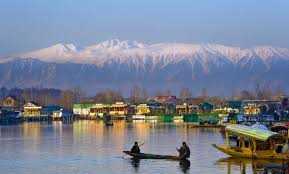
Jammu and Kashmir is undergoing a historic transformation, shedding decades of conflict and stagnation to emerge as one of India’s fastest-growing regions. With its economy projected to reach ₹2.65 lakh crore, the Union Territory is charting a new course driven by investment, infrastructure, and inclusive development.
J&K has consistently recorded over 7% annual growth between 2021-22 and 2024-25. This momentum is powered by robust infrastructure projects, a surge in tourism, rising private investment, and impactful welfare schemes. Since 2019, government initiatives such as Ayushman Bharat, universal drinking water supply, and over 1.7 lakh houses built under PM Awas Yojana have significantly improved living standards.
Job creation and entrepreneurship are also on the rise, with more than 30,000 government positions filled and over 650 startups launched in recent years. The 2021 Industrial Policy and New Central Sector Scheme have attracted investment proposals worth ₹1.63 lakh crore, potentially creating around six lakh jobs. Nearly 2,000 new industrial units are already operational.
Tourism — a vital pillar of J&K’s economy — has reached record levels, with over 2.11 crore visitors in 2023. Enhanced security, better road connectivity, winter sports in Gulmarg, eco-tourism, and upgraded religious destinations are drawing tourists year-round. The G20 Tourism Working Group meeting in Srinagar further boosted J&K’s global profile.
Massive infrastructure projects like the Chenab Railway Bridge, Zojila and Z-Morh tunnels, new highways, and upgraded airports in Srinagar, Jammu, and Leh are improving connectivity and trade. Upcoming metro rail systems and logistics parks aim to modernize urban transport.
Energy and digital advancements are also reshaping the region. Hydropower projects — including Ratle, Kishanganga, and Pakal Dul — along with solar initiatives, are enhancing power capacity. Digital governance has expanded, with over 1,100 services accessible online through the eUNNAT portal. The discovery of lithium in Reasi adds a strategic dimension, supporting India’s clean energy goals.
Youth skilling in artificial intelligence, cloud computing, and cybersecurity underscores a vision of blending renewable energy with digital innovation. Meanwhile, dual-use infrastructure strengthens both civilian development and national security in this strategic border region.
With growth projected to accelerate to nearly 10% in the coming years, Jammu and Kashmir is positioning itself as a new engine of India’s economic rise — a story of resilience, opportunity, and transformation.
Jammu and Kashmir is undergoing a historic transformation, shedding decades of conflict and stagnation to emerge as one of India’s fastest-growing regions. With its economy projected to reach ₹2.65 lakh crore, the Union Territory is charting a new course driven by investment, infrastructure, and inclusive development.
J&K has consistently recorded over 7% annual growth between 2021-22 and 2024-25. This momentum is powered by robust infrastructure projects, a surge in tourism, rising private investment, and impactful welfare schemes. Since 2019, government initiatives such as Ayushman Bharat, universal drinking water supply, and over 1.7 lakh houses built under PM Awas Yojana have significantly improved living standards.
Job creation and entrepreneurship are also on the rise, with more than 30,000 government positions filled and over 650 startups launched in recent years. The 2021 Industrial Policy and New Central Sector Scheme have attracted investment proposals worth ₹1.63 lakh crore, potentially creating around six lakh jobs. Nearly 2,000 new industrial units are already operational.
Tourism — a vital pillar of J&K’s economy — has reached record levels, with over 2.11 crore visitors in 2023. Enhanced security, better road connectivity, winter sports in Gulmarg, eco-tourism, and upgraded religious destinations are drawing tourists year-round. The G20 Tourism Working Group meeting in Srinagar further boosted J&K’s global profile.
Massive infrastructure projects like the Chenab Railway Bridge, Zojila and Z-Morh tunnels, new highways, and upgraded airports in Srinagar, Jammu, and Leh are improving connectivity and trade. Upcoming metro rail systems and logistics parks aim to modernize urban transport.
Energy and digital advancements are also reshaping the region. Hydropower projects — including Ratle, Kishanganga, and Pakal Dul — along with solar initiatives, are enhancing power capacity. Digital governance has expanded, with over 1,100 services accessible online through the eUNNAT portal. The discovery of lithium in Reasi adds a strategic dimension, supporting India’s clean energy goals.
Youth skilling in artificial intelligence, cloud computing, and cybersecurity underscores a vision of blending renewable energy with digital innovation. Meanwhile, dual-use infrastructure strengthens both civilian development and national security in this strategic border region.
With growth projected to accelerate to nearly 10% in the coming years, Jammu and Kashmir is positioning itself as a new engine of India’s economic rise — a story of resilience, opportunity, and transformation.
© Copyright 2023 brighterkashmir.com All Rights Reserved. Quantum Technologies